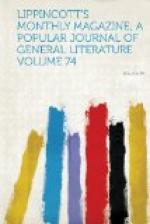What more amiable example of give-and-take than the intertwining of birch and orange, the thin ghostly sprays of the hyperborean caressing the fragrant leaf and golden globes of the sub-tropical? This, and other conjunctions less eloquent of contrast, may be seen on the headland of Zeffoun or Cape Corbelin. They stand out from a prevailing background of the familiar forest trees of temperate Europe and America—the ash, elm, beech, oak, fir and walnut. The orchards, above those of oranges and lemons, are of figs and olives. The cork-oak covers considerable tracts, but is less attended to than in Spain. A non-European aspect is imparted by the tufts of cactus and aloes which abound in the most arid localities.
[Illustration: The Djurjura range.]
Wherever intelligent farming is met with in Northern Africa it is a safe assertion that the Kabyles are either on the spot or not far off. Like other farmers, they are conservative and adhere to old rules or fancies, which in some cases verge upon superstition. The practice of fertilizing fig trees by hanging them with fruits of the wild fig is one of those which it is difficult to class—whether with the visionary or the practical. Be that as it may, people who know nothing about figs except to eat them have no right to a say in the matter. Tradition and experience are in favor of the Kabyle. He does what has been done since Aristotle, Theophrastus and Pliny, all of whom insist on “caprification” as essential to a large crop of figs adapted to drying. He will go or send many miles to procure the wild fruit if it does not grow in his neighborhood, and the traffic in it reaches a value of some thousands of dollars annually, trains of thirty, fifty and sixty mule-loads passing from one tribe to another. As with other valuable things, this inedible fruit is food for quarrelling. The tribe which is rich in the dokhar, or wild fig, is fortunate, and especially so if its neighbors have none or if their crop of it fails. It is then able to “bull the market,” and proceeds to do so with a promptness and vim that would turn a Wall street operator blue with envy. But it is compelled to take account of troubles in its path unknown at the Board. The party who is “short” on dokhar may be “long” on matchlocks. If so, the speculation is apt to come to an unhappy end. A sudden raid will capture the stock and at once equalize the market. To many communities figs are at once meat and pocket-money. To lose the harvest is not to be thought of. The aspect of the means of preventing such a disaster is altogether a secondary consideration. Dokhar at all hazards is the cry of men, women and children. The comparative cessation of fig-wars is one of the blessings due to French rule.
[Illustration: Road across the Djurjura at mount TIROURDA.]




